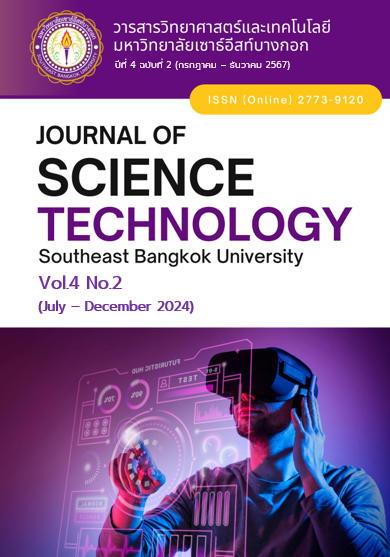การประยุกต์สถาปัตยกรรมองค์กรเต็มรูปแบบเพื่อพัฒนาเว็บแอปพลิเคชัน บทความวิจัย
Main Article Content
บทคัดย่อ
การพัฒนาระบบซอฟต์แวร์ในปัจจุบัน ด้วยขนาดของระบบที่มีความซับซ้อนและมีการขยายตัวเพิ่มขึ้นจากความต้องการการใช้งานที่เปลี่ยนแปลง ส่งผลให้เกิดแนวทางการพัฒนาการดำเนินงานบนระบบซอฟต์แวร์ AngularJS โดยใช้แนวคิดสถาปัตยกรรม Model-View-Controller มาศึกษาเพื่อแยกส่วนการทำงานอย่างอิสระต่อกันในงานวิจัยนี้ วัตถุประสงค์ของงานวิจัย 1) เพื่อพัฒนาและจัดการทุกชั้นของระบบเว็บแอปพลิเคชัน ตั้งแต่ frontend และ backend ไปจนถึง infrastructure และ 2) เพื่อพัฒนาระบบสารสนเทศเพื่อการจัดการเอกสาร มคอ.3 และ มคอ.5 จากการสุ่มกลุ่มตัวอย่าง จำนวน 40 คน เป็นอาจารย์ผู้สอนของมหาวิทยาลัยเซาธ์อีสท์บางกอกที่มีแผนการจัดการเรียนการสอนและมีความเข้าใจในเอกสารมคอ. จึงเหมาะต่อการเก็บกลุ่มตัวอย่างผู้ใช้งาน เครื่องมือที่ใช้วัดและประเมินผลเป็นแบบประเมินประสิทธิภาพ โดยการวัดแบบมาตราส่วน 5 ระดับ ตามแนวคิดของ Good ที่ทำให้เห็นภาพรวมผลการดำเนินงานและความสามารถในการทำงานตามมาตรฐาน และใช้ซอฟต์แวร์ AngularJS แบบ Model-View-Controller Architecture เพื่อพัฒนาและออกแบบเว็บแอปพลิเคชัน ตามแนวคิดของ Martin Fowler จากผลการวิจัย พบว่าซอฟต์แวร์ที่ใช้สามารถแยกความรับผิดชอบแต่ละส่วนอย่างอิสระต่อกัน และเกิดประสิทธิภาพต่อผู้ใช้งานระบบ ในด้านของหมวดการเรียนรู้ที่ต้องการใช้งาน หมวดการใช้งานง่าย เมื่อเทียบกับระบบเดิม (เอกสาร) และหมวดการเข้าถึงระบบและการเรียกใช้ออนไลน์ ซึ่งภาพรวมอยู่ในระดับ (ดี) มากที่สุด ( X ̅ = 4.56, S.D. = 0.48) ดังนั้น การออกแบบและพัฒนาเว็บแอปพลิเคชันด้วยแนวทางนี้จึงเป็นทางเลือกที่เหมาะสมกับยุคที่ต้องการการพัฒนาซอฟต์แวร์ที่รวดเร็ว ยืดหยุ่น และสามารถบำรุงรักษาได้ในระยะยาว
Article Details

อนุญาตภายใต้เงื่อนไข Creative Commons Attribution-NonCommercial-NoDerivatives 4.0 International License.
บทความที่ได้รับการตีพิมพ์และเป็นลิขสิทธิ์ของวารสารวิทยาศาสตร์และเทคโนโลยี มหาวิทยาลัยเซาธ์อีสท์บางกอก
เอกสารอ้างอิง
M. Fowler, Patterns of enterprise application architecture. Boston: Addison-Wesley Professional Publishers, 2002.
R. Martin and M. Martin, Agile principles, patterns, and practices in C#. London: Pearson Education Publishers, 2006.
R. Conery, S. Hanselman, P. Haack, and S. Guthrie, Microsoft application architecture guide 2nd edition (pattern & practices). California: Microsoft Press Publishers, 2009.
P. Saint-Louis, M. C. Morency, and J. Lapalme, “Examination of explicit definitions of enterprise architecture,” International Journal of Engineering Business Management, vol. 11, pp. 1–18, Jun. 2019.
L. Halawi, R. McCarthy, and J. Farah, “Where we are with enterprise architecture,” Journal of Information Systems Applied Research, vol. 12, no. 3, pp. 4–13, Dec. 2019.
M. Fowler, “Who needs an architect?,” IEEE Software, vol. 20, no. 5, pp. 11–13, Sep.–Oct. 2003.
J. Nurmi, K. Penttinen, and V. Seppänen, “Examining enterprise architecture definitions: Implications from theory and practice,” Selected Papers of the IRIS, no. 9, pp. 1–13, 2019.
D. Venkatesan and S. Sridhar, “A rationale for the choice of enterprise architecture method and software technology in a software-driven enterprise,” International Journal of Business Information Systems, vol. 32, no. 3, pp. 272–311, Oct. 2019.
K. Svyatoslav, “TOGAF-based enterprise architecture practice: An exploratory case study,” Communications of the Association for Information Systems, vol. 43, pp. 321–359, Sep. 2018.
E. Atencio, M. Mancini, and G. Bustos, “Enterprise architecture approach for project-based organizations modeling, design, and analysis: An ontology-driven tool proposal,” Alexandria Engineering Journal, vol. 98, pp. 312–327, Jul. 2024.
C. V. Good, W. R. Merkel, and P. D. Kappa, Dictionary of education, 3rd ed. New York: McGraw-Hill Publishers, 1973.


